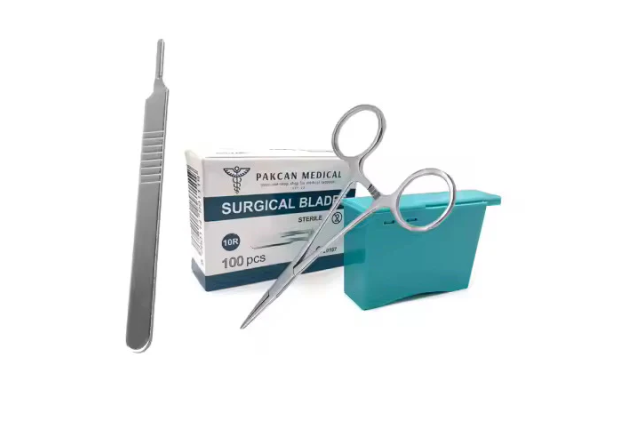Choosing the Right Scalpel Blade for Your Surgical Procedure

Strong 8k brings an ultra-HD IPTV experience to your living room and your pocket.
Scalpel blades and other surgical metallic instruments are major instruments in a surgeon's toolkit. They can be used in various procedures, from simple incisions to intricate surgeries requiring precision and minimal invasiveness. As Australia's healthcare system values patient safety and high-quality medical products, selecting the right scalpel blade for a particular surgical procedure is crucial. This guide will take you through the types of scalpel blades, considerations while choosing the best one, and the best practices for scalpel blade use.
Understanding Scalpel Blades and Their Role in Surgery
High-quality stainless steel is the normal forging material of scalpel blades. But some blades are made of carbon steel, titanium, and even aluminium. Their sharpness, precision, and durability make scalpel blades most valued in the operating room.
Scalpel blades are meant for various specific types of surgeries; they come in different sizes, shapes, and designs. Choosing the appropriate blade will enable surgeons to achieve clean and accurate incisions without causing trauma around surrounding tissues.
Types of Scalpel Blades and Their Uses
1. #10 Blade: The Classic This scalpel blade is the most commonly used blade in general surgery. The curved cutting edge makes it possible to make long incisions in soft tissue, like abdominal surgery.
2. #11 Blade: Precision for Puncture Incisions The #11 blade has a pointed tip and a straight cutting edge, which is very efficient in making small, precise cuts. It is mainly used in operations requiring puncture or stab incisions like those in drainage of abscesses or skin biopsies. This blade is also most commonly used in microeye surgery because of its acuity.
3. #15 Blade: A Versatile Blade Suitable for Small Incisions The #15 blade, a smaller version of the #10 blade, is often used during the fine, carefully defined incision nature of delicate surgical procedures. It is well-suited to minor incisions, such as during plastic or reconstructive surgery. For instance, it is often chosen in pediatric surgeries because it is easy to make precise cuts in smaller areas.
4. #20 Blade: Larger Option Heavy Tissue Incision "When a surgeon wants to make a bigger incision on heavy tissue-whether it's muscle or fat-the blade of choice is usually the #20," she notes, adding that such a blade tends to be used in extensive surgeries, including some orthopedic procedures.
5. Custom Blades: The custom blades can be further in size and shape according to the need of the procedure, and they are available through specialized surgical equipment suppliers. Custom blades are mostly used in areas like neurosurgery or cardiac surgery.
Factors to Consider When Choosing a Scalpel Blade
The decision on which scalpel blade to use depends on several factors, including the type of procedure, the area of surgery, and the surgeon's preference. Below are the key considerations:
1. Procedure Type: The most important factor among all these is the procedure type. Generally, for major surgery, the number 10 or number 11 blades are termed the best, whereas, for delicate procedures like cosmetic surgery and microsurgery, blades like number 15 or 12 are preferred because smaller blades are needed for finer work. Understanding this will direct the selection process.
2. Tissue Type: Certain types of blades are made for cutting particular tissues. For example, harder tissue requires a blade with a much more durable edge, while delicate tissue requires a fine, sharp tip. The anatomy of the human body in the area to be incised determines blade choice.
3. Patient's Health and Age: Small or chronic patients may be treated more gently and are better suited to a finer, smaller blade such as #15. Fragile skin or scar tissue is a consideration for blade choice, as patients with that type of skin will be less likely to suffer damage during the surgery.
4. Surgeon's Preference: All blades can perform several functions; however, a surgeon's familiarity with a certain blade can also make a huge difference in the results of a surgery. Surgeons mostly prefer several brands or types of blades because of their grip, design, and overall performance during the surgery.
5. Sterilization and Safety: Like all other surgical instruments, scalpel blades must be sterile. In Australia, scalpel blades are often sold as pre-sterile and packaged for single use to uphold a high safety standard. However, a proper sterilization process is needed for reuse.
Top Scalpel Blade Suppliers in Australia
Several renowned and well-established medical equipment suppliers in Australia offer various types of scalpel blades and other surgical instruments of unmatched quality. These suppliers make available numerous scalpel blades intended for use by healthcare professionals in every corner of the country.
• Aspen Medical: They have a wide range of surgical instrument offerings and sell scalpel blades from some of the most trusted brands, like Swann-Morton.
• Medline Australia: High-quality surgical blades and scalpels for Australia are the medico quality assurance from Medline Australia that they provide to ensure all supplies comply with very strict Australian healthcare standards.
• Medical and Surgical Supplies Australia (MSSA): MSSA provides an expansive range of scalpel blades and surgical accessories to make it easy for healthcare professionals to find everything in one offering.
Safety and Handling of Scalpel Blades
As per safety standards in Australia, surgical scalpels are handled extremely carefully. Healthcare professionals must follow procedures for safe handling and disposal of scalpels to reduce the risk of accidental injuries. Use safety scalpels or scalpel handles with retractable blades wherever possible to minimize risk.
Tips for Safe Handling:
1. Use the proper protective gear for handling scalpels.
2. Dispose of scalpel blades properly in designated biohazard containers.
3. Follow the specific sterilization and storage requirements for scalpel blades per the institution to maintain optimum hygiene.
Studies and Insights on Scalpel Blade Performance
A study published in the Australian Journal of Surgery in 2020 highlighted the importance of sharpness and precision in scalpel blades for reducing surgical complications. According to the study, "The sharper the blade, the less trauma it causes to surrounding tissues, leading to faster healing and reduced scarring."
Another study by the National Library of Medicine (NLM) discussed the performance of scalpel blades made from different materials, concluding that "Stainless steel blades, due to their resistance to corrosion and sharpness, are the most widely preferred for both standard and delicate surgeries."
Conclusion
The surgeon must select the right blade before surgery. That blade is vital in making cancer surgery as less traumatic as possible for the patient and allowing for a quicker recovery. It is very personal and best derived through careful consideration by the Australian surgeon about the type of procedure and area of tissue involved in the individual preference. For example, you may require blades for general, delicate, or special surgery. Still, you can make an informed decision only when you understand the appropriate options.
By relying on trusted suppliers and ensuring compliance with safety standards, healthcare professionals assist in proving high-level efficiency in scalpel blades in their surgical outcomes in Australia.
References:
1. Australian Journal of Surgery, 2020 - "The Impact of Blade Sharpness on Surgical Outcomes"
2. National Library of Medicine - "Material Science of Surgical Blades: A Comparative Study"
Note: IndiBlogHub features both user-submitted and editorial content. We do not verify third-party contributions. Read our Disclaimer and Privacy Policyfor details.


